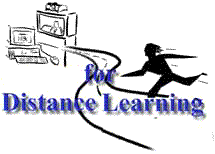|
|
Today the premise of Distance Learning is still just a promise. At moments
each of us sometimes wonder what is truly meant by "distance learning". One
concept of distance learning is a learning style that breaks the traditional ranks of
sitting in a classroom with a pen in hand taking notes as the instructor lectures.
With today's technology computers are replacing notebooks, mice are replacing
pens, and instructors are able to be in a number of different places at one time.
Through the efforts of the La. State Board of Regents and its members and the
forthcoming Internet 2 Network it is easy to believe that we can apply "traditional
beliefs" or methodologies to a "distance" learning style.
Traditionally we have all come to realize that as the turn of the century
approaches and technology blazes on at the speed of light, that traditional modernist
approaches and beliefs will be literature spoken for in our history books. While
many of us are familiar with the term Distance Education, Distance Learning may be
a new topic. Another definition of Distance Learning is "the teaching/learning
environment where institution and student are not face-to-face in the classroom but
are joined by alternative communication systems"(Drichta 1997). In addressing the
practical application of Distance Education in Distance Learning it is important to
realize some issues including modes of delivery, policy issues and terminology.
While it would be highly advantageous to discuss all the terminology facing the
adult student, it is not beneficial at this time to provide a long list of terms.
This learning style includes several modes of delivery; remote site
instruction, print and correspondence, broadcast television, live or recorded one-
way audio/visual, computer-based learning, two-way audio and one-way visual,
two-way audio/visual and multimedia in the classroom. Curricular development
approaches to each of these delivery modes is open to many opinions and ideas and
can serve the needs of both modern and postmodern epistemology.
The University of New Orleans has been a part of the Distance Education
movement in the New Orleans area for over a decade. Since the inception of credit
education offerings in local high schools, to now where classes are taught on a day to
day basis in Jefferson, Slidell, Downtown New Orleans, and the Westbank. The
|
|


 1-2
3-4
5-6
7-8
9-10
11-12
13-14
15-16
17-18
1-2
3-4
5-6
7-8
9-10
11-12
13-14
15-16
17-18



 1-2
3-4
5-6
7-8
9-10
11-12
13-14
15-16
17-18
1-2
3-4
5-6
7-8
9-10
11-12
13-14
15-16
17-18

